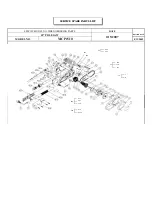
English
13
side of the saw blade. Guide along the penciled cutting line so that
the kerf falls into the waste or surplus material. Figure 9 shows the
dimensions of the shoe. The right dimension is 1-1/2" (38 mm).
Adjusting Depth Adjustment Lever
(Fig. 9)
It may be desirable to adjust the Depth Adjustment Lever. (It will
sometimes swing below the bottom of the shoe before tightening
or loosening completely.) To adjust lever, follow the steps below.
1. TURN OFF THE TOOL AND REMOVE THE BATTERY PACK.
2. Using a small screwdriver, pry off the lock ring.
3. Remove the lever and rotate it in the desired direction about
1/8 revolution (more or less as necessary).
4. Reinstall the lever and insert the lock ring with
concave side
against lever to hold it in place.
OPERATION
Switch
Release lock-off by pressing button (Fig. 10, U). Pull the trigger
switch to turn the motor ON. Releasing the trigger turns the motor
FIG. 9
LOCK NUT
LOCK RING
LEVER
TIGHTEN
LOOSEN
FIG. 10
U
OFF. Releasing the trigger also automatically actuates lock off but-
ton.
NOTE:
This tool has no provision to lock the switch in the ON
position, and should never be locked in the ON position by any
other means.
Workpiece Support
Figure 11 shows proper sawing position. Note that hands are kept
away from cutting area. When using the AC adapter, be sure the
power cord is positioned clear of the cutting area so that it will not
get caught or hung up on the work.
WARNING:
It is important to support the work properly and to
hold the saw firmly to prevent loss of control which could cause per-
sonal injury.
ALWAYS DISCONNECT SAW BEFORE MAKING ANY ADJUST-
MENTS!
Place the work with its “good” side – the one on which
appearance is most important – down. The saw cuts upward, so
any splintering will be on the work face that is up when you saw it.
1.
IMPROPER WORKPIECE SUPPORT
A. Sagging or improper lifting of the cut off piece causing pinch-
ing of the blade.
B. Cutting through material supported at the outer ends only
(see Figures 12 and 13). As the material weakens it sags,
closing down the kerf and pinching the blade.
FIG. 11















































